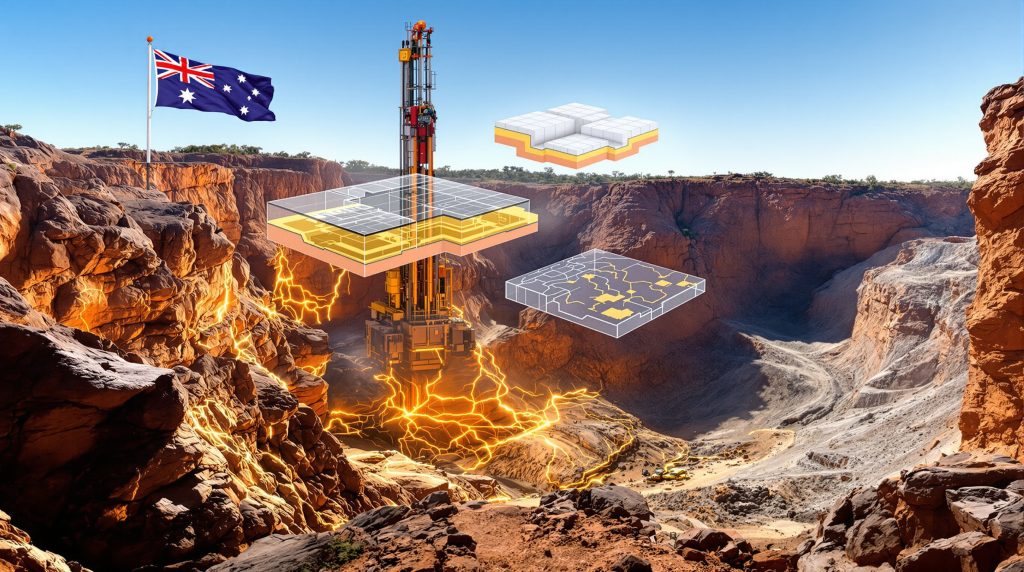Understanding the Thomson Farm-in Agreement
Rio Tinto Exploration has entered into a significant farm-in and joint venture option agreement with Legacy Minerals for the Thomson project in New South Wales. This strategic partnership represents a major development in Australian copper-gold exploration, allowing Rio Tinto to gain up to 80% joint venture interest through staged exploration funding worth up to $25 million.
The agreement follows a structured approach common in mining exploration partnerships. Initially, Rio Tinto will provide minimum exploration funding of $400,000 within the first six months alongside a $50,000 cash payment to Legacy Minerals. Following this initial phase, Rio Tinto can earn a 75% joint venture interest by sole-funding $5 million of exploration activities within five years, with a requirement to complete at least 3,000 meters of drilling. Should exploration prove successful, Rio Tinto has the opportunity to increase its stake to 80% by investing an additional $20 million over a subsequent five-year period.
This type of staged farm-in structure aligns incentives between both companies while reducing upfront capital requirements, a common and effective strategy in the mining sector for managing exploration risk.
Strategic Importance of the Thomson Project
Geological Potential and Location
The Thomson project represents one of the largest tenement holdings in New South Wales, strategically located near the Thomson Orogen contact with the Lachlan Fold Belt. This geological setting shares significant similarities with several intrusion-related copper-gold districts globally, particularly the Paterson Province in Western Australia where major discoveries have emerged in recent years.
Geologists have identified extensive hydrothermal alteration across the project area, with mineralization patterns suggesting the potential for large-scale copper-gold systems. According to data from the NSW Department of Regional NSW, the state has significant prospectivity for these types of deposits, particularly in the Lachlan Fold Belt and adjacent regions.
The geological significance cannot be overstated – the Thomson Orogen represents a Paleozoic-age orogenic belt in eastern Australia characterized by complex structural and metamorphic histories that are known to host substantial mineral deposits.
Comparison to Winu: A Successful Exploration Model
To understand the Thomson project's potential, we can look to Rio Tinto's previous exploration success in similar geological settings. The Winu project in Western Australia's Paterson Province, discovered by Rio Tinto in 2017, has demonstrated remarkable resource potential with approximately 3 million tonnes of copper and 8 million ounces of silver identified.
Winu serves as proof of concept for Rio Tinto's exploration model in these geological environments. The project is currently advancing toward development through a joint venture with Sumitomo Metal Mining, with Rio Tinto holding a 60% stake. Beyond copper and silver, Winu also contains significant gold resources, with plans for an open-pit operation and processing plant.
Mutual Benefits of the Partnership
Advantages for Legacy Minerals
For Legacy Minerals, this partnership represents a transformative opportunity that delivers multiple benefits without diluting shareholder equity. By partnering with one of the world's largest mining companies, Legacy gains access to Rio Tinto's substantial technical knowledge, global exploration expertise, and specific experience with intrusion-related copper-gold systems.
The agreement provides Legacy with significant exploration funding that would otherwise be difficult to secure independently. Most importantly, it validates the project's potential, as major mining companies like Rio Tinto conduct extensive due diligence before committing to exploration investments.
Legacy Minerals' CEO and Managing Director Christopher Byrne emphasized the significance of the partnership: "Securing one of the world's largest mining companies as a partner on the Thomson Project is of huge significance. It allows Legacy Minerals to leverage Rio Tinto's global expertise in discovery, development and its knowledge of intrusion-related copper and gold systems through its discovery of the Winu deposit."
Strategic Value for Rio Tinto
From Rio Tinto's perspective, the Thomson project aligns perfectly with their strategic objectives to expand their copper and gold exploration portfolio while securing early-stage access to potentially world-class deposits. Copper remains a priority metal for major mining companies due to its critical role in renewable energy technology and electrification.
This farm-in agreement allows Rio Tinto to:
- Apply their specialized expertise in intrusion-related systems
- Diversify geographical presence in prospective regions
- Conduct staged investment based on exploration results
- Strengthen their pipeline of future development opportunities
- Secure potential supply sources in politically stable jurisdictions
The Value of Intrusion-Related Copper-Gold Systems
Geological Characteristics and Economic Importance
Intrusion-related copper-gold systems represent some of the world's most economically significant mineral deposits. These geological formations typically develop when metal-rich fluids are expelled from cooling magma chambers, depositing valuable minerals in surrounding rock formations.
These systems offer substantial economic advantages:
- Large-scale mineralization with extensive resource potential
- Multi-commodity value (copper, gold, and often silver)
- Long mine life potential due to size and grade distribution
- Amenability to bulk mining methods, improving economics
- Potential for satellite discoveries within the same system
According to the United States Geological Survey (USGS), porphyry copper deposits, a common type of intrusion-related system, account for approximately 60% of global copper production and represent the most significant source of newly mined copper worldwide.
Global Significance in Copper-Gold Exploration
The industry focus on intrusion-related systems reflects broader global trends in mineral exploration importance:
- Growing global demand for copper in renewable energy and electrification
- Continued strong investment interest in gold as a store of value
- Declining discovery rates of tier-one copper-gold deposits globally
- Increasing technical sophistication in exploring for these systems
- Rising importance of securing future supply in politically stable jurisdictions
Major producing examples of intrusion-related copper-gold systems include Cadia-Ridgeway in NSW (operated by Newcrest Mining), Oyu Tolgoi in Mongolia (operated by Rio Tinto), and Grasberg in Indonesia (operated by Freeport-McMoRan).
Next Steps for the Thomson Project
Immediate Exploration Plans
The initial six-month period will focus on establishing the foundation for the exploration program through:
- Detailed geological mapping and surface sampling
- Geophysical surveys to refine drill targets
- Review of historical exploration data
- Target prioritization for the initial drilling program
- Planning for the minimum 3,000-meter drilling commitment
These early activities will help define the most promising areas within the large tenement package for subsequent drilling programs overview.
Long-term Development Pathway
If exploration proves successful, the Thomson project could follow a development pathway similar to other Rio Tinto discoveries:
- Resource definition through systematic drilling
- Preliminary economic assessment of development options
- Environmental and social impact studies
- Feasibility studies and engineering design
- Potential mine development decision
This typical progression would span several years, with comprehensive exploration taking 2-5 years, resource definition requiring 1-2 years, feasibility studies spanning 2-3 years, and construction taking 2-4 years if development proceeds. Under this timeline, potential production would not begin until the early 2030s at the earliest.
Regional Exploration Context
New South Wales Exploration Renaissance
The Thomson project is part of a broader resurgence in mineral exploration across New South Wales, driven by:
- Increased recognition of the state's copper-gold potential
- Application of modern exploration techniques to historically underexplored areas
- Growing investment in greenfield exploration
- Government initiatives supporting resource development
- Renewed focus on critical minerals for the energy transition
The NSW Government has been actively promoting mineral exploration through initiatives including the Critical Minerals and High-Tech Metals Strategy, exploration incentive programs, and streamlined approvals for exploration activities.
Global Copper-Gold Exploration Hotspots
The Thomson project sits within a global context of copper-gold exploration, alongside other active regions:
- Paterson Province (Western Australia)
- Atacama Desert (Chile)
- Andean Copper Belt (Peru)
- Golden Triangle (British Columbia)
- Central Asian Orogenic Belt
These regions share geological characteristics that make them highly prospective for copper-gold discoveries, with exploration techniques and knowledge often transferable between regions.
Implications for Future Copper-Gold Supply
Contribution to Meeting Demand
Successful development of the Thomson project could have significant implications for future mineral supply:
- Help address projected copper supply deficits forecast by industry analysts
- Contribute to Australia's position as a major copper producer
- Support the growing demand for copper in renewable energy technologies
- Provide a secure supply source from a politically stable jurisdiction
- Add to global gold production at a time of declining discovery rates
According to the International Energy Agency (IEA) World Energy Outlook, achieving global climate goals will require substantial increases in copper production, with demand potentially doubling by 2040 compared to 2020 levels. Electric vehicles require 2-3 times more copper than conventional vehicles, creating significant demand pressure.
Supply Challenges and Timeline Considerations
The copper market faces several significant challenges that make new discoveries particularly valuable:
- Declining ore grades at existing operations
- Long lead times for new mine development (typically 10-15 years from discovery to production)
- Increasing difficulty in making new tier-one discoveries (deposits containing >500,000 tonnes of copper)
These factors underscore the importance of exploration partnerships like the Rio Tinto-Legacy Minerals agreement, though investors and stakeholders should recognize that any potential production remains years away. Additionally, copper price predictions suggest strong future demand, making new discoveries increasingly valuable.
Farm-in Agreement FAQ
What is a farm-in agreement in mining?
A farm-in agreement allows one company (the "farmee") to earn an interest in a mining project by funding exploration or development activities, rather than purchasing the interest outright. This structure aligns incentives and reduces upfront capital requirements for both parties.
How common are farm-in agreements for major mining companies?
Farm-in agreements are a standard strategy for major mining companies to access early-stage projects without committing to full ownership immediately. They provide a staged approach to investment based on exploration success, allowing companies like Rio Tinto to manage risk while maintaining access to promising projects.
What factors will determine the success of the Thomson exploration program?
Success will depend on multiple factors including:
- Geological findings from initial surveys and drilling
- The grade, continuity, and scale of any mineralization discovered
- Metallurgical characteristics of the ore
- Economic factors including commodity prices and development costs
- Regulatory and environmental considerations
What is the significance of the 3,000-meter drilling commitment?
The 3,000-meter drilling commitment represents a substantial initial drilling program that will test multiple targets across the project area. This level of drilling can provide critical data about subsurface geology, mineralization styles, and potential resource extent. In exploration terms, this represents a meaningful commitment to thoroughly evaluate the project's potential.
How does this agreement compare to other Rio Tinto exploration partnerships?
The structure aligns with Rio Tinto's typical approach to exploration partnerships, featuring staged investment tied to exploration milestones and increasing ownership percentages based on funding commitments. This approach allows Rio Tinto to allocate capital efficiently across their global exploration portfolio while maintaining focus on the most promising projects.
Key Agreement Terms
| Aspect | Details |
|---|---|
| Agreement Type | Farm-in and joint venture option |
| Maximum Rio Tinto Interest | 80% |
| Total Potential Investment | $25 million |
| Initial Exploration Period | 6 months |
| Initial Funding Commitment | $400,000 minimum |
| Cash Payment to Legacy | $50,000 |
| First Earning Phase | 75% interest for $5 million over 5 years |
| Second Earning Phase | Additional 5% for $20 million over 5 years |
| Minimum Drilling Commitment | 3,000 meters |
Market and Industry Implications
The Rio Tinto-Legacy Minerals agreement for the Thomson project reflects broader industry trends toward strategic partnerships in copper exploration. As existing copper mines face grade decline and depletion, major mining companies are increasingly focused on securing future supply through early-stage exploration investments.
This agreement also highlights the growing recognition of Australia's continued mineral potential, particularly for copper-gold systems that can support the global energy transition. New South Wales, with its established mining infrastructure and supportive regulatory environment, represents an attractive jurisdiction for exploration investment.
For investors and industry observers, the Rio Tinto Exploration Thomson farm-in development demonstrates the long-term perspective of major mining companies like Rio Tinto, who continue to invest in exploration despite the inherent risks and extended timeframes involved in bringing new discoveries to production. Furthermore, successful drilling results interpretation will be crucial for advancing the project through its various stages.
Current Australian exploration trends suggest continued interest in copper-gold systems, particularly as the global energy transition accelerates demand for critical minerals.
Disclaimer: This article contains forward-looking statements about exploration potential and development timelines. Mineral exploration involves significant risks, uncertainties, and long timeframes. There is no guarantee that exploration activities will result in the discovery of economically viable mineral deposits or that any discoveries will be developed into producing mines.
Want to Catch the Next Major Mineral Discovery?
Discovery Alert's proprietary Discovery IQ model instantly notifies subscribers of significant ASX mineral discoveries, translating complex exploration announcements into actionable investment opportunities. Learn how historic discoveries have generated exceptional returns by visiting the Discovery Alert discoveries page and position yourself ahead of the market with your 30-day free trial.




